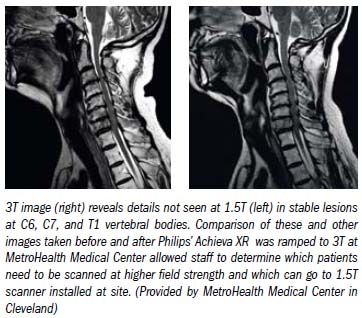How to get the gain without the pain in shift to 3T MR
With its add-on software and higher performance coils, field-upgradeable MR scanners are the lifeblood of the imaging community. But systems with upgradeable fields are rare.
With its add-on software and higher performance coils, field-upgradeable MR scanners are the lifeblood of the imaging community. But systems with upgradeable fields are rare.
Philips Healthcare debuted the idea at RSNA 2006, touting its Achieva XR as the first and, so far, only 1.5T product that can be upgraded in the field to 3T. Thirty-nine of these multifield systems have been put in place since the device's unveiling. Philips argued that its Achieva XR can serve as a kind of insurance policy against obsolescence. Customers not ready to take the leap to 3T, Philips said, can use the Achieva XR at 1.5T indefinitely with the assurance that a higher field strength is just an upgrade away.
MetroHealth bought the scanner but not the argument. The 500-bed hospital ran its Achieva XR at 1.5T for only a month before ramping it to 3T. The idea was to teach staff the new Philips interface using a familiar field strength.

“We had some reservations about making this double jump, going to a new platform and going to 3T, so this offered us the opportunity to ease into it,” said Pedro Diaz, Ph.D., vice chair of imaging and informatics systems at MetroHealth.
Replacing its existing 1.5T scanner with the new Achieva XR spanned several weeks, according to Diaz. But the transition from 1.5T to 3T was done in a few days.
Scanning at 3T then began with the same user interface as at 1.5T, using the same patient setup, same coils, and, consequently, the same knowledge base. What staff had learned to do at 1.5T was applicable at 3T, Diaz said.
“Philips did a really good job of helping us find the replacement sequences for 3T,” he said.
Typically sites making this jump must compare images at the two field strengths taken on wholly different machines, possibly from different vendors. The Achieva XR provided MetroHealth the opportunity to directly compare 1.5T and 3T images taken under conditions that differed only in field strength. This baseline allowed staff to determine which patients are best imaged on the 3T Achieva and which on the 1.5T Philips scanner, also newly acquired.
The only cases now going automatically to 3T at MetroHealth are the obvious ones: spectroscopy, diffusion tensor imaging, and functional imaging. High-resolution brain angiography is done, when warranted, at 3T. Conversely, body MR scans that Diaz thought could be done only on the 1.5T machine because of artifacts typically associated with 3T, can, in fact, be done on the higher field scanner.
Both machines can handle routine scans. Achieva XR offers advantages in speed, due to the improved signal-to-noise ratio available at 3T, with the option of trading speed for better resolution. This kind of interchangeability was the goal behind MetroHealth's transition to two Philips high-field scanners.
“One of our fears was that everyone would want to have every patient done at 3T,” Diaz said. “The way we did it allowed us to make convincing arguments about what really absolutely needed to be done at 3T.”
Emerging AI Algorithm Shows Promise for Abbreviated Breast MRI in Multicenter Study
April 25th 2025An artificial intelligence algorithm for dynamic contrast-enhanced breast MRI offered a 93.9 percent AUC for breast cancer detection, and a 92.3 percent sensitivity in BI-RADS 3 cases, according to new research presented at the Society for Breast Imaging (SBI) conference.
The Reading Room Podcast: Current Perspectives on the Updated Appropriate Use Criteria for Brain PET
March 18th 2025In a new podcast, Satoshi Minoshima, M.D., Ph.D., and James Williams, Ph.D., share their insights on the recently updated appropriate use criteria for amyloid PET and tau PET in patients with mild cognitive impairment.
Can Abbreviated Breast MRI Have an Impact in Assessing Post-Neoadjuvant Chemotherapy Response?
April 24th 2025New research presented at the Society for Breast Imaging (SBI) conference suggests that abbreviated MRI is comparable to full MRI in assessing pathologic complete response to neoadjuvant chemotherapy for breast cancer.
Clarius Mobile Health Unveils Anterior Knee Feature for Handheld Ultrasound
April 23rd 2025The T-Mode Anterior Knee feature reportedly offers a combination of automated segmentation and real-time conversion of grayscale ultrasound images into color-coded visuals that bolster understanding for novice ultrasound users.